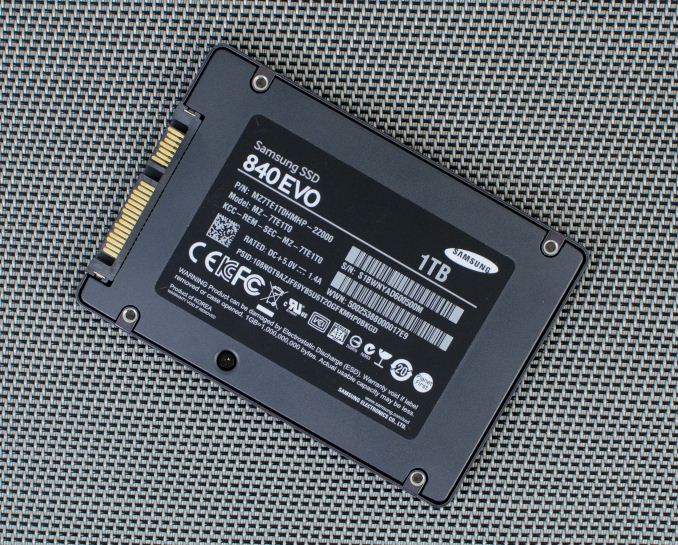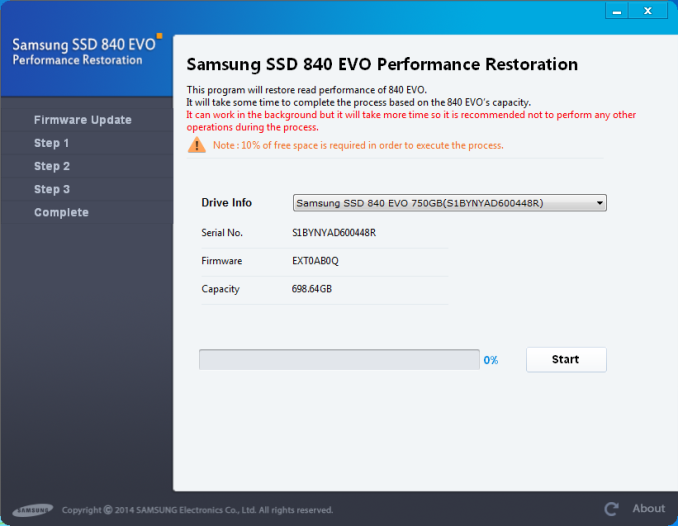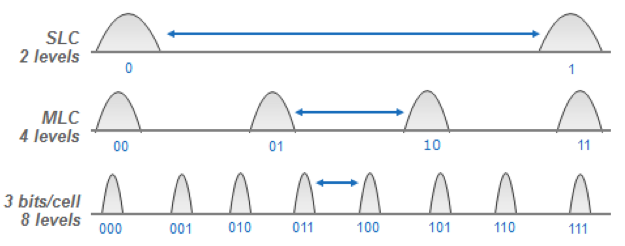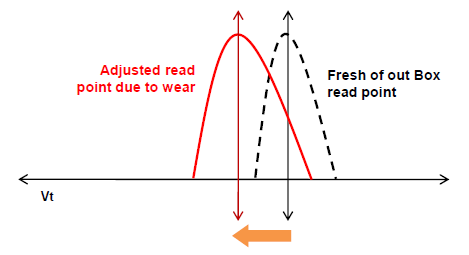Samsung Releases Firmware Update to Fix the SSD 840 EVO Read Performance Bug
by Kristian Vättö on October 16, 2014 2:40 PM EST
The news of Samsung's SSD 840 EVO read performance degradation started circulating around the Internet about a month ago. Shortly after this, Samsung announced that they have found the fix and a firmware update is expected to be released on October 15th. Samsung kept its promise and delivered the update yesterday through its website (download here).
The fix is actually a bit more than just a firmware update. Because the bug specifically affects the read speed of old data, simply flashing the firmware isn't enough. The data in the drive has to be rewritten for the changes in the new firmware to take place. Thus the fix comes in the form of a separate tool, which Samsung calls Performance Restoration Software.
For now the tool is limited to the 840 EVO (both 2.5" and mSATA) and will only work under Windows. An OS-independent tool will be available later this month for Mac and Linux users, but currently there is no word on whether the 'vanilla' 840 and the OEM versions will get the update. Samsung told me that they've only seen the issue in the 840 EVO, although user reports suggested that the 'vanilla' 840 is affected as well. I'll provide an update as soon as I hear more from Samsung.
The performance restoration process itself is simple and doesn't require any input from the user once started. Basically, the tool will first update the firmware and ask for a shut down after the update has been completed. Upon the next startup the tool will run the actual three-step restoration process, although unfortunately I don't have any further information about what these steps actually do. What I do know is that all data in the drive will be rewritten and thus the process can take a while depending on how much data you have stored in your drive. Note that the process isn't destructive if completed successfully, but since there is always a risk of data loss when updating the firmware, I strongly recommend that you make sure that you have an up-to-date backup of your data before starting the process.
The restoration tool has a few limitations, though. First, it will require at least 10% of free space or the tool won't run at all, and there is no way around the 10% limitation other than deleting or moving files to another drive before running the tool. Secondly, only NTFS file system is supported at this stage, so Mac and Linux users will have to wait for the DOS version of the tool that is scheduled to be available by the end of this month. Thirdly, the tool doesn't support RAID arrays, meaning that if you are running two or more 840 EVOs in a RAID array, you'll need to delete the array and switch back to AHCI mode before the tool can be run. Any hardware encryption (TCG Opal 2.0 & eDrive) must be disabled too.
In regards to driver and platform support, the tool supports both Intel and AMD chipsets and storage drivers as well as the native Microsoft AHCI drivers. The only limitation is with AMD storage drivers where the driver must be the latest version, or alternatively you can temporarily switch to the Microsoft driver by uninstalling the AMD driver. Samsung has a detailed installation guide that goes through the driver switch process along with the rest of the performance restoration process.
Explaining the Bug
Given the wide spread of the issue, there has been quite a bit of speculation about what is causing the read performance to degrade over time. I didn't officially post my theory here, although I did Tweet about it and also mentioned it in the comments of the original news post. It turns out that my theory ended up being pretty much spot on as Samsung finally disclosed some details of the source of the bug.
As most of you likely know already, the way NAND works is by storing a charge in the floating gate. The amount of charge determines the voltage state of the cell, which in turn translates to the bit output. Reading a cell basically works by sensing the cell voltage, which works by increasing the threshold voltage until the cell responds.
However, the cell charge is subject to multiple variables over time. Electron leakage through the tunnel oxide reduces the cell charge over time and may result in a change in the voltage state. The neighboring cells also have an impact through cell-to-cell interference in the form of floating gate coupling, which is at its strongest when programming a neighbor (or just a nearby) cell. That will affect the charge in the cell and the effect becomes stronger over time if the cell isn't erased and reprogrammed for a long time (i.e. more neighbor cell programs = more interference = bigger shift in cell charge).
Because cell voltage change is a characteristic of NAND, all SSDs and other NAND-based devices utilize NAND management algorithm that takes the changes into account. The algorithm is designed to adjust the voltage states based on the variables (in reality there are far more than the two I mentioned above) so that the cell can be read and programmed efficiently.
In case of the 840 EVO, there was an error in the algorithm that resulted in an aggressive read-retry process when reading old data. With TLC NAND more sophisticated NAND management is needed due to the closer distribution of the voltage states. At the same time the wear-leveling algorithms need to be as efficient as possible (i.e. write as little as possible to save P/E cycles), so that's why the bug only exists on the 840 and 840 EVO. I suspect that the algorithm didn't take the change in cell voltage properly into account, which translated into corrupted read points and thus the read process had to be repeated multiple times before the cell would return the correct value. Obviously it takes more time if the read process has to be performed multiple times, so the user performance suffered as a result.
Unfortunately I don't have an 840 EVO that fits the criterion of the bug (i.e. a drive with several months old data), so I couldn't test more than the restoration process itself (which was smooth, by the way). However, PC Perspective's and The Tech Report's tests confirm that the tool restores the performance back to the original speeds. It's too early to say whether the update fixes long-term performance, but Samsung assured that the update does actually fix the NAND management algorithm and should thus be a permanent fix.
The EVO has been the most popular retail SSD so far, so it's great to see Samsung providing a fix in such a short time. None of the big SSD manufacturers have been able to avoid widespread bugs (remember the 8MB bug in the Intel SSD 320 and the 5,000-hour bug in the Crucial m4?) and I have to give Samsung credit for handling this well. In the end, this bug never resulted in data loss, so it was more of an annoyance than a real threat.













95 Comments
View All Comments
omgyeti - Thursday, October 16, 2014 - link
I'm wondering if this implies a similarity to their upcoming replacement for the 840 EVO that isn't shared with the Vanilla 840. I love that they put this fix out for the current model, but I can't help but wonder if they might not have released it without knowing that the same fix was going to prevent this issue from popping up in the next model.chizow - Thursday, October 16, 2014 - link
Could always press the issue via RMA. Just say its a known defect that has impacted your drive, Samsung has acknowledged it but won't fix it, and that you demand a comparable drive that does not have this problem. Only alternative would be to give you an EVO. I have a 250GB 840 in my wife's desktop, she hasn't complained about performance drop (not that she would even notice it probably) so I am not sure if I will pursue RMA.Anyways, ran this on one of my EVOs and it finished np, took about 20 minutes for a 500GB.
Bkord123 - Thursday, October 16, 2014 - link
So sick of these assholes releasing Windows only software. Your shit is fucked up on all fronts, fix it the right way.Oxford Guy - Friday, October 17, 2014 - link
If I had had a choice I would have gotten a different drive but my Macbook Pro came with one. I've never been a fan of TLC and the reasons why continue to multiply.Romberry - Friday, October 17, 2014 - link
Because coming out first with the fix for over 9 out of 10 in the user base is just so awful, right? You choose a platform that has miniscule share, you have to live with the reality that the vast majority on other platforms come first.Oxford Guy - Friday, October 17, 2014 - link
If a company can't support a product properly it shouldn't see it to those customers.fmaxwell - Sunday, October 19, 2014 - link
Yes, it is awful, because the OS-independent tool would work for Windows, too. But such a large percentage of Windows users lack even the meager technical skills required to copy an ISO image to a CD or thumb drive and boot from that. So Samsung had to release a "Special Olympics" Windows version of the tool first to avoid being bombarded with support requests from the nitwits.Mikemk - Thursday, October 16, 2014 - link
"Mac and Linux users will have to wait for the DOS version of the tool"I think you mean UNIX?
Coup27 - Thursday, October 16, 2014 - link
Samsung call it a DOS version, but I think you are correct.cygnus1 - Thursday, October 16, 2014 - link
No. It's not a UNIX version. They are making a bootable version of the tool and it will run in freedos most likely. This will be useable on non-NTFS systems